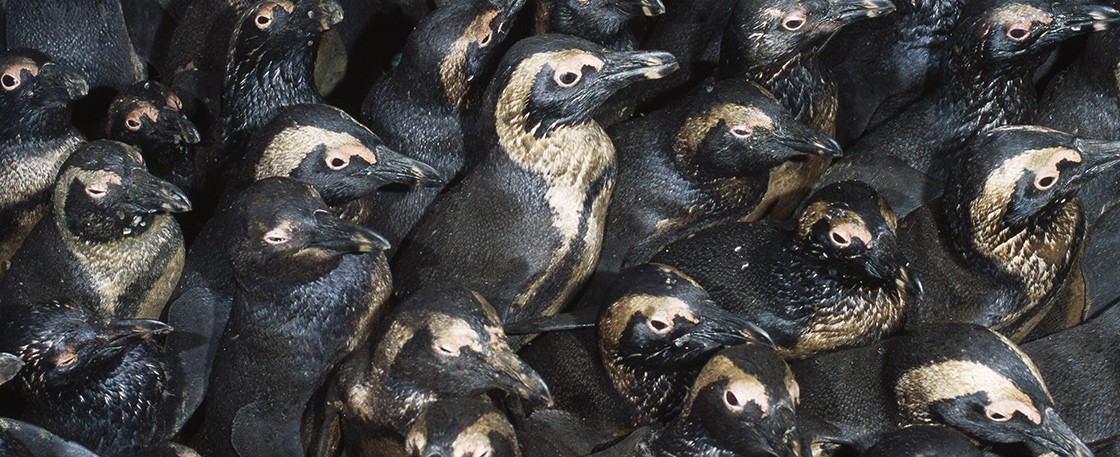Imagine you are an African penguin. The year is 2000. You live on an island in the South Atlantic Ocean. You are with thousands of other penguins on a rocky beach. Even though it’s June, it’s cold and windy. All around you are penguin noises: barks and honks. Some of your penguin friends fight for their space. Others cuddle with their partners and take care of their chicks.
You’re hungry, so you head down to the water’s edge. You waddle on tiny feet. Your wings are too stubby for flying. But in the water, you can swim faster and dive deeper than almost any bird on Earth. After you plunge into the sea, you shoot through the water, just a black-and-white blur. You snatch sardines near the surface. Your thick feathers protect you from the freezing water.
You stay in the sea for hours until your belly is full of sardines. Then you head back to shore.
That’s when something goes wrong.
As you come to the surface for air, the water feels strange. It is thick. It stings your eyes. You try to swim away, but now your wings are too heavy to lift. You can barely catch your breath.
What you don’t know is that just hours ago, a ship called Treasure hit a reef and split apart. As it sank, 1,300 tons of oil gushed into the sea. Thousands of penguins have been soaked with the poisonous oil.
Imagine you are an African penguin. You live on a beach with your penguin friends. One day you are swimming in the ocean. This is usually fun. But today the water feels thick. It stings your eyes. Your wings are too heavy to lift. You can barely catch your breath.
That’s because a ship hit a reef. Then it split apart. The ship was carrying oil. The oil spilled into the sea. Now you and other penguins are covered in the oil. This oil could kill you.
Imagine you are an African penguin. The year is 2000. You live on an island in the South Atlantic Ocean. You are with thousands of penguins on a beach. Even though it’s June, it’s cold and windy. You hear penguin noises: barks and honks. Some of your penguin friends fight for their space. Others cuddle with their partners. They take care of their chicks.
You’re hungry. You head down to the water’s edge. You waddle on tiny feet. Your wings are too stubby for flying. But in the water, you can swim faster and dive deeper than almost any bird on Earth. After you plunge into the sea, you shoot through the water. You grab sardines to eat. Your feathers protect you from the freezing water.
You stay in the sea for hours. When your belly is full of sardines, you head back to shore.
That’s when something goes wrong.
You come to the surface for air. But the water feels strange. It is thick. It stings your eyes. You try to swim away. But now your wings are too heavy to lift. You can barely catch your breath.
You don’t know it, but hours ago, a ship called Treasure hit a reef. Then it split apart. As it sank, 1,300 tons of oil gushed into the sea. Thousands of penguins are soaked with the poisonous oil.
Imagine you are an African penguin living on an island in the middle of the South Atlantic Ocean. You live with tens of thousands of other penguins on a rocky beach. It’s a typical day there in June—cold and windy. The beach echoes with penguin noises, barks and honks and brays. Some of your fellow penguins fight for territory. Others cuddle with their mates and dote on their chicks.
You’re hungry, so you head down to the water’s edge. You waddle on tiny feet, and your wings are too stubby for flying. But in the water, you can swim faster and dive deeper than almost any bird on Earth. As you plunge into the sea, your wings become powerful underwater propellers. You shoot through the water at 12 miles an hour, a black-and-white blur, snatching sardines from the surface, swallowing them whole, then catching more. Your thick feathers protect you from the freezing water.
You stay in the sea for hours until your belly is full. Then you turn to head back to shore.
That’s when something goes wrong.
As you come to the surface for air, the water feels unfamiliar. It is thick, and it burns your eyes. You try to swim away, but suddenly your wings are too heavy to lift and you can barely propel yourself. Your body wobbles and rolls. You feel bitterly cold. You shiver and gasp for breath.
What you don’t know is that just hours ago, a cargo ship called Treasure hit a reef and split apart. As it sank, 1,300 tons of toxic crude oil gushed into the sea. Oil surrounds your breeding ground—the largest African penguin breeding ground in the world.
You are not the only penguin that has become soaked with the poisonous oil. Thousands of others have been trapped in the massive oil slick.
The impact of oil on a penguin (or any bird) is immediate and devastating. You are shivering because the oil has caused your layers of feathers to separate. Freezing water now lashes at your sensitive skin. Your eyes hurt because the oil has burned them. Your wings are heavy because they are coated with oil.
But your instinct for survival is strong. Somehow you struggle back to shore, fighting the waves and the current. The trip, usually effortless, is an agonizing ordeal. You manage to stagger onto the beach and back to your nest. You lick and peck at your feathers, desperate to clean them. Finally you give up. There is nothing to do but stand there, terrified, dazed, and silent.

